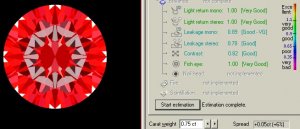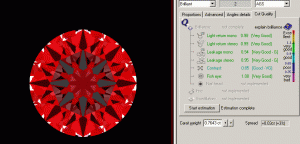AN ANALYSIS OF INACCURACIES IN THE HOLLOWAY CUT ADVISER (HCA)
Authors: Derek Louey
Study Type: Qualitative
Aim:
To determine the cause of discrepancies between HCA reports and actual diamond appraisals for HCA scores > 2
History:
Various cut-grading systems have been developed to assist buyers in evaluating diamond quality. These systems are still based on deviationsfrom a single set of proportions defined by Tolkowsky more than 80 yearsago. However, recent research from the GIA and MSU has cast significant doubts on the validity of existing systems in commercial use and have clearly shown that there are multiple sets of equally ideal proportions that have not been previously considered. The HCA is a grading system that has incorporated these findings to achieve a more accurate estimation of diamond appearance. The author states that HCA is an accurate guide to selection in at least 80% of reasonable symmetric diamonds. Possible reasons for inaccuracy include asymmetry and minor facet proportion variations. Other factors may be due to inter-individual variation in subjective perception and viewing diamonds
that are illuminated from below the plane of the girdle. This study attempts to analyze in further detail the factors that impact on diamond appraisal.
Method:
A poll will be taken on an internet-based open discussion group, Rocky Talky diamond forum on Pricescope. Requests will be made for subjective evaluations on diamonds that participants believe have been given wrong scores by HCA.
Garry Holloway (the author of the HCA) or other participants will make available Ideal-Scope and GemAdviser files of the diamond utilising DiamCalc (a proprietary 3-D imaging program) accompanied by any relevant comments.
Participants on Rocky Talky will be invited to provide useful comments on the reason for the discrepancy in the examples given.
The following information should be provided by the submitter:
Proportion data
Full HCA evaluation including light return, brilliance and fire (as per https://www.pricescope.com/cutadviser.asp website)
Name of submitter
Including brief outline of credentials e.g. consumer, professional appraiser, jeweller, gem-cutter, amateur gemologist, appraiser's personal assessment etc.
Opinion of the diamond
Utilizing the terminology of HCA (e.g. excellent, very good, good, fair, poor), if possible Ideal-Scope photo, full Sarin report (including symmetry details where available) and certificate gradings.
Period of study:
Indefinite
Declaration of interest:
As above

Authors: Derek Louey
Study Type: Qualitative
Aim:
To determine the cause of discrepancies between HCA reports and actual diamond appraisals for HCA scores > 2
History:
Various cut-grading systems have been developed to assist buyers in evaluating diamond quality. These systems are still based on deviationsfrom a single set of proportions defined by Tolkowsky more than 80 yearsago. However, recent research from the GIA and MSU has cast significant doubts on the validity of existing systems in commercial use and have clearly shown that there are multiple sets of equally ideal proportions that have not been previously considered. The HCA is a grading system that has incorporated these findings to achieve a more accurate estimation of diamond appearance. The author states that HCA is an accurate guide to selection in at least 80% of reasonable symmetric diamonds. Possible reasons for inaccuracy include asymmetry and minor facet proportion variations. Other factors may be due to inter-individual variation in subjective perception and viewing diamonds
that are illuminated from below the plane of the girdle. This study attempts to analyze in further detail the factors that impact on diamond appraisal.
Method:
A poll will be taken on an internet-based open discussion group, Rocky Talky diamond forum on Pricescope. Requests will be made for subjective evaluations on diamonds that participants believe have been given wrong scores by HCA.
Garry Holloway (the author of the HCA) or other participants will make available Ideal-Scope and GemAdviser files of the diamond utilising DiamCalc (a proprietary 3-D imaging program) accompanied by any relevant comments.
Participants on Rocky Talky will be invited to provide useful comments on the reason for the discrepancy in the examples given.
The following information should be provided by the submitter:
Proportion data
Full HCA evaluation including light return, brilliance and fire (as per https://www.pricescope.com/cutadviser.asp website)
Name of submitter
Including brief outline of credentials e.g. consumer, professional appraiser, jeweller, gem-cutter, amateur gemologist, appraiser's personal assessment etc.
Opinion of the diamond
Utilizing the terminology of HCA (e.g. excellent, very good, good, fair, poor), if possible Ideal-Scope photo, full Sarin report (including symmetry details where available) and certificate gradings.
Period of study:
Indefinite
Declaration of interest:
As above










300x240.png)